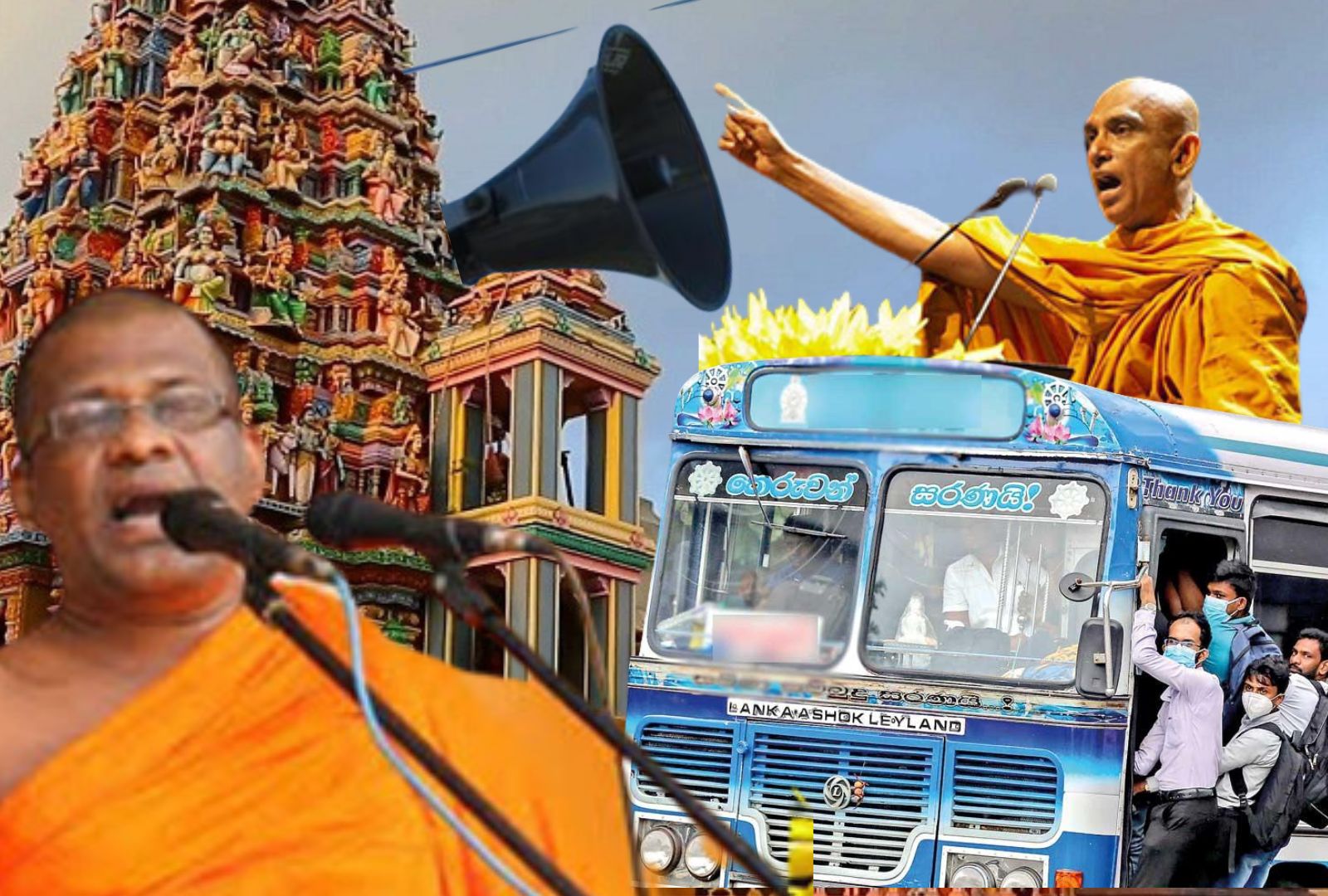Although I live in the United States, over the years I’ve returned to Sri Lanka many times. It’s not the tourist attractions that keep pulling me back — it’s the deep personal connections I’ve formed with the people here. If I had found a reliable means of supporting myself on the island, I would have made Sri Lanka my primary residence, only returning to the U.S. a few times a year. Maybe that will still happen at some point in the future.
And yet, I have to confess: at times my relationship with this island feels like a love–hate affair. Not with the people I care about — but with some of the maddening aspects of daily life. And one of the worst offenders, one of the most sanity-shredding realities here, is noise pollution.
The Boundary Problem
There’s a glaring lack of boundaries here — as though many people don’t recognize where they end and another person begins. Nowhere is this more obvious than in the relentless sonic assault so many of us endure.
When I stay in Balagolla, in the Central Highlands near Kandy, I’m often woken between 4:30 and 5:30 a.m. by a recording of Buddhist monks chanting, blasted through loudspeakers into the pre-dawn dark … only to hear the same wailing chants again between 6 and 7 p.m. My first half-awake response? “Is that the sound of a cow dying? Or a flashback to a really bad acid trip?”
At one time, I had a close friendship with a Buddhist monk — a friend I regret losing touch with. I’ve known monks, like him, who were genuinely kind and compassionate. But let’s be honest: in Sri Lanka, much of the monkhood has long been synonymous with Sinhala nationalism — angry incels in ochre whose repressed rage and hypocrisy spill into toxic rhetoric, the same fuel that decades ago ignited the Black July pogroms, the bloodshed of Tamils, and the nearly thirty-year war that followed. So forgive me if I have little patience when their chanting blares through the air like an unwanted alarm clock.
Sacred Spaces or Sonic Nightmares?
In Kilinochchi — once the de facto capital of the rebel fighting force known as the Tamil Tigers (LTTE) — the volume gets even louder. Hindu temples (Kovils) that should be sanctuaries often turn into open-air torture chambers for the ears. The puja itself and the sound of the nagaswaran are fine — even beautiful. But why the need to blast religious music and rambling sermons at ear-splitting volumes for hours on end?
What about the children living within half a mile who need to study or sleep? What about the men and women who leave for work at dawn and return late in the evening, only to find their rest shattered by amplified devotional “tunes” that start as early as 4 a.m. and sometimes go past midnight? Many of my Tamil friends near these Kovils complain they barely get sleep during festival weeks. The priests and organizers seem grossly insensitive to the pleas of the community to turn the volume down.
And let’s not forget the obvious: constant exposure to high-decibel noise is physically damaging. It’s not just an irritation — its hearing loss waiting to happen.
When Worship of Any Kind Crosses Boundaries
And let me be clear — my frustration isn’t directed only at Buddhist monks or Hindu Kovils. I have a deep respect for these traditions. In fact, there are a lot of similarities between some Buddhist practices and the system of meditation I’ve developed and teach. I have also attended and even taken part in festivals at some of the Kovils in Kilinochchi and Jaffna. On one occasion, I did ask them, “Will you please turn the volume down so you’re not damaging my own and other people’s hearing?” They accommodated, which I deeply appreciated.
Actually, Sri Lanka does have laws against excessive noise, yet they are rarely enforced. Friends in Kilinochchi tell me that the police, often corrupt and incompetent, side with those causing the disturbance — even going so far as to reveal the names of the people who complain, and that can cause problems for them in their communities.
What I object to isn’t the practice or the celebration itself, but when devotion crosses the line into noise pollution. If a mosque or a Christian church decided to blast its prayers, sermons, or hymns at ear-splitting volume, subjecting me — and everyone within a half-mile radius — to their chosen form of devotion, I’d be just as furious. Worship of any kind should never become an excuse to trample on everyone else’s right to peace and quiet.
Buses and Sinhala Pop Hell
Then there are the buses. Riding a bus in Sri Lanka is already its own kind of suffering — crammed in like sardines, sweat dripping, and bodies pressed together. But the real torment is the music. Drivers and conductors love to blast Sinhala pop tunes at volumes that make your heart palpitate.
I don’t mind Tamil music, but Sinhala pop — to my ears — is unbearable. I’d rather take the train, even if it takes me considerably longer to reach my destination, just to avoid it. I hate much of American pop music too, so this isn’t just cultural bias — it’s an aversion to being force-fed noise I never asked for.
On numerous occasions, I’ve asked conductors to turn the volume down. Sometimes they oblige. Other times they ignore me. And a few times, when I reached my breaking point, I got up and pulled the wires right out of the speaker next to me.
Noise is Pollution
Noise — whether it’s chanting, religious music, or pop tunes — is a form of pollution. It creates stress. It prevents us from relaxing, from digesting our lived experiences, from simply being present with ourselves. It builds tension and aggravation, adding to our exhaustion.
What so many here fail to recognize is that not everyone wants to hear what they’re blasting. Many of us want to sit with our own thoughts and feelings — not be forced to endure a nonstop barrage of unwanted sound.
Silence as Sacred: Teachings from the Tamil Saints and the Buddha
When I speak out against the blaring of loudspeakers from Kovils, temples, mosques, and churches, I am not dismissing devotion itself. What troubles me is how far these practices have drifted from the deeper wisdom of their own traditions — wisdom that has long exalted silence, stillness, and inward turning as the true path to the divine.
Among the Tamil people, some of the most revered sages have spoken of silence as the highest teaching. Ramana Maharshi, one of the greatest holy men of the twentieth century and a son of Tamil Nadu, often taught without uttering a word. His very presence in silence was said to communicate more than hours of discourse. He once remarked, “Silence is also conversation,” reminding us that truth is not found in endless noise but in the quiet presence of being.
Centuries before him, the poet-saint Tiruvalluvar, author of the Tirukkural — one of the crown jewels of Tamil literature — wrote lines that remain timeless: “Silence is the fence around wisdom.” He warned that restraint in speech is itself a form of knowledge, and that silence often surpasses words in power.
Another Tamil mystic, Thayumanavar, poured out verses on the futility of external clamor and the sacredness of inner stillness. For him, mauna — silence — was not emptiness but the doorway into communion with the divine. The Siddhar traditions of Tamil Nadu echoed this same truth, urging seekers to turn inward rather than lose themselves in outward display.
Even the Buddha, whose teachings gave rise to the Theravāda tradition practiced across Sri Lanka, held silence in the highest regard. He often remained in what is called “noble silence” (ariya tuṇhībhāva) when questions could not be answered with words alone. In the Dhammapada, the Buddha compares the enlightened one to a broken gong that no longer makes a sound — silent not from emptiness, but from inner peace and self-mastery.
These voices — Tamil saints, Siddhars, and the Buddha himself — all point toward the same truth: that true devotion and true wisdom are found not in blasting sound into the ears of neighbors and strangers, but in cultivating the silence that allows us to listen to the depths of our own being. To drown out whole communities with endless chants and amplified prayers and devotional tunes is not fidelity to these traditions — it is, in fact, a departure from their most profound teachings.
A Call for Sanity
It would be refreshing — revolutionary, even — and an enormous relief for those of us who simply desire peace of mind, if people here became more aware of the concept of boundaries. Don’t blast your noise into everyone else’s ears. Be considerate. Allow others the gift of peace.
But I don’t expect this to happen on its own. Which is why I believe Sri Lanka should follow the example of Kerala, India, where police now issue citations and hefty fines to Kovils and others blasting music at obscene volumes. The only way to curb this high decibel madness may be through punitive action against the worst offenders.
Until then, we’ll keep enduring the endless wails of monks, the distorted blare of temple music, and the buses blasting Sinhala pop hell — Sri Lanka an island of beauty drowning in its own noise.
©Copyright 2025 Ben Oofana. All Rights Reserved.
Ben Oofana is a gifted healer who began his training at the age of twenty with Horace Daukei, one of the last surviving traditional doctors (medicine men) among the Kiowa Indian Tribe. Ben helps people to heal their bodies, minds, broken hearts and other deep emotional wounds while helping them to increase their capacity to love and be loved, realize their true potential and fulfill their life's purpose.







Leave A Comment